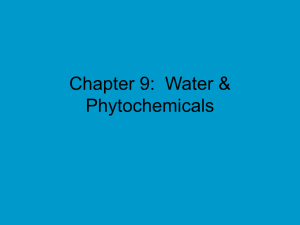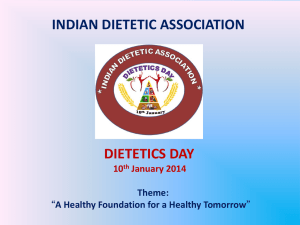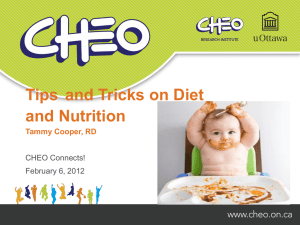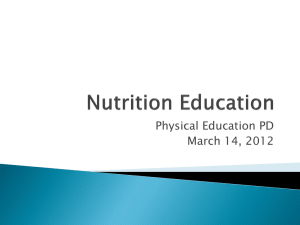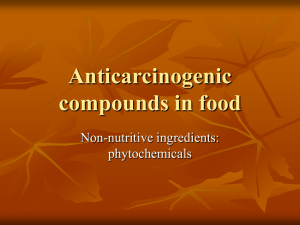Why eat the Rainbow? - Botanical Research Center
advertisement
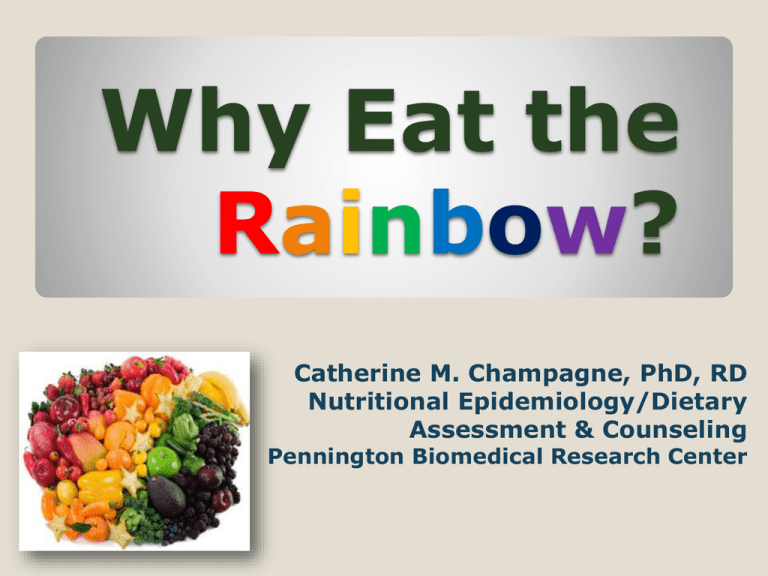
Why Eat the Rainbow? Catherine M. Champagne, PhD, RD Nutritional Epidemiology/Dietary Assessment & Counseling Pennington Biomedical Research Center Why worry about color? Think health – think color The richer the color in foods the more potent natural chemicals they contain. Eat Colorful Foods!!!! They contain phytochemicals The term is generally used to refer to those chemicals that may affect health, but are not yet established as essential nutrients. Abundant scientific and government support for recommending diets rich in fruits and vegetables. Only limited evidence that health benefits are due to specific phytochemicals. Therefore, eat the rainbow!!! Phytochemicals Allicin Carotenoids Phenols and cyclic compounds Isothiocyanates and indoles Flavonoids Lignans Resveratrol Lutein Sulforaphane Lycopene Zeaxanthin Anthocyanins Ellagic acid What can phytochemicals do? Function as antioxidants Enhance your immune response May alter estrogen metabolism Cause cancer cells to die (apoptosis) Repair DNA damage caused by toxic compounds Detoxify carcinogens Oxygen Radical Absorbance Capacity (ORAC) A method of measuring antioxidant capacities in biological samples A wide variety of foods have been tested using this methodology, with certain spices, berries, and legumes rated very highly High antioxidants from a diet rich in colorful fruits and vegetables is believed to play a role in the free-radical theory of aging (aging better!!) USDA data on foods with high ORAC scores Food Serving size Small Red Bean ½ cup dried beans 13727 Wild blueberries 1 cup 13427 Red kidney bean ½ cup dried beans 13259 Pinto bean ½ cup 11864 Blueberries, cultivated 1 cup 9019 Cranberries 1 cup 8983 Artichoke hearts 1 cup, cooked 7904 Blackberries, cultivated 1 cup 7701 Prunes ½ cup 7291 Raspberries 1 cup 6058 *measured as Trolox Equivalents Antioxidant content USDA data on foods with high ORAC scores Food Serving size Strawberries 1 cup 5938 Red Delicious apple 1 apple 5900 Granny Smith apple 1 apple 5381 Pecans 1 oz 5095 Sweet cherry 1 cup 4873 Black plum 1 plum 4844 Russet potato 1, cooked 4649 Black beans ½ cup dried beans 4181 Plum 1 plum 4118 Gala apple 1 apple 3903 *measured as Trolox Equivalents Antioxidant content Something else to note With nearly all vegetables, conventional boiling reduces the ORAC value significantly, while steaming retains more of the antioxidants. So, it is clear that you will get less impact with dried or raw beans following cooking (my guess is about 90% less). Importance of eating peelings Ever heard this saying? Peppy Pearly eats peelings, Droopy Delsey doesn’t Check out the apple story next ORAC Food Values FOOD Serving size Antioxidant content* Apples, Red Delicious, raw, with skin 1 medium 7781 Apples, Red Delicious, raw, without skin 1 medium 4727 Apples, Golden Delicious, raw, with skin 1 medium 4859 Apples, Golden Delicious, raw, without skin 1 medium 3558 *measured as Trolox Equivalents A Word of Caution The relationship between ORAC values and health benefits has not been established. While this information is useful, remember that we need more scientifically controlled studies. Beware of marketing that suggests their products are #1 in ORAC! It is not known whether such values are accurate or how absorbable and functional these concentrated antioxidants are in the human body. The Red Group They add anthocyanins, betacyanins and lycopenes Lycopene is a bright red carotene/carotenoid pigment found in tomatoes and other red fruits & vegetables (but not strawberries or cherries) What about the REDS?? Red in your diet will help maintain: A healthy heart Memory function Urinary tract health (cranberries) Lower risk of some cancers Of the top 20 antioxidant fruits and vegetables, 7 are red: Strawberries Cranberries Raspberries Cherries Red grapes Beets Red peppers The Group foods are a great source of carotenoids Beta Carotene is a provitamin A carotenoid, which means it can be converted into Vitamin A. in your diet will… Help maintain: A healthy heart Night vision Healthy immune system Lower risk of cancer Antioxidants in fruits and vegetables help prevent cataracts and protect the body from other types of damage from free radicals. The Vegetables Carrots Sweet potatoes Yellow potatoes Pumpkins Squash Corn Yellow peppers Foods: Fruits Oranges Tangerines Grapefruit Mangoes Cantaloupe Apricots Bananas The Green Group Green foods are a great source of lutein and zeaxanthin Lutein is actually a yellow-orange pigment, but is masked by the chlorophyll in green foods. The Power of Green Foods Antioxidants present in green fruits and vegetables can: Help prevent macular degeneration Help prevent cataracts Can lower risk of some cancers The Green Group Found in: Kiwi Spinach Green grapes Green pepper Honeydew Broccoli Limes Romaine Lettuce The Blue-Purple Group Blue-Purple foods are a great source of anthocyanins and resveratrol Resveratrol is found in the skin of grapes and is present in purple grape juice and red wine. The Blue-Purple Group may: Protect against heart disease Have anti-aging effects Prevent urinary tract infections Have anti-cancer properties The Blue-Purple Group Found in: Blueberries Blackberries Grapes Plums Purple Cabbage Purple Onion Eggplant Purple peppers Purple Endive The Group foods are a great source of allicin, indoles, and allyl sulfides . They can help maintain heart health and lower risk of some cancers. foods include: Onions Garlic Cauliflower Apples Plantains Shallots Summing it all up For more information……. Color Code’s Top 10 Vegetables: Red ◦ Tomatoes ◦ Red bell peppers Orange-Yellow Green ◦ Kale ◦ Broccoli ◦ Spinach ◦ Carrots Blue-Purple ◦ Sweet ◦ Purple cabbage potatoes ◦ Eggplant ◦ Winter squash Color Code’s Top 10 Fruits: Red ◦ Strawberries ◦ Raspberries Orange- Yellow ◦ Oranges ◦ Mangoes ◦ Grapefruit Green ◦Kiwi ◦Avocado Blue-Purple ◦ Blueberries ◦ Concord grapes ◦ Dried plums Consider Blueberries! A USDA database reveals that blueberries contain more than a dozen vitamins and minerals in small amounts. They pack fiber. And they contain nearly 100 different phytochemicals!!! Some data suggests blueberries help memory. Is there more??????
